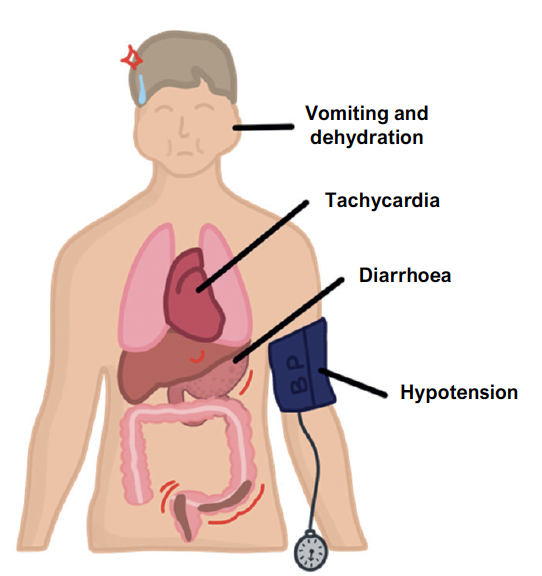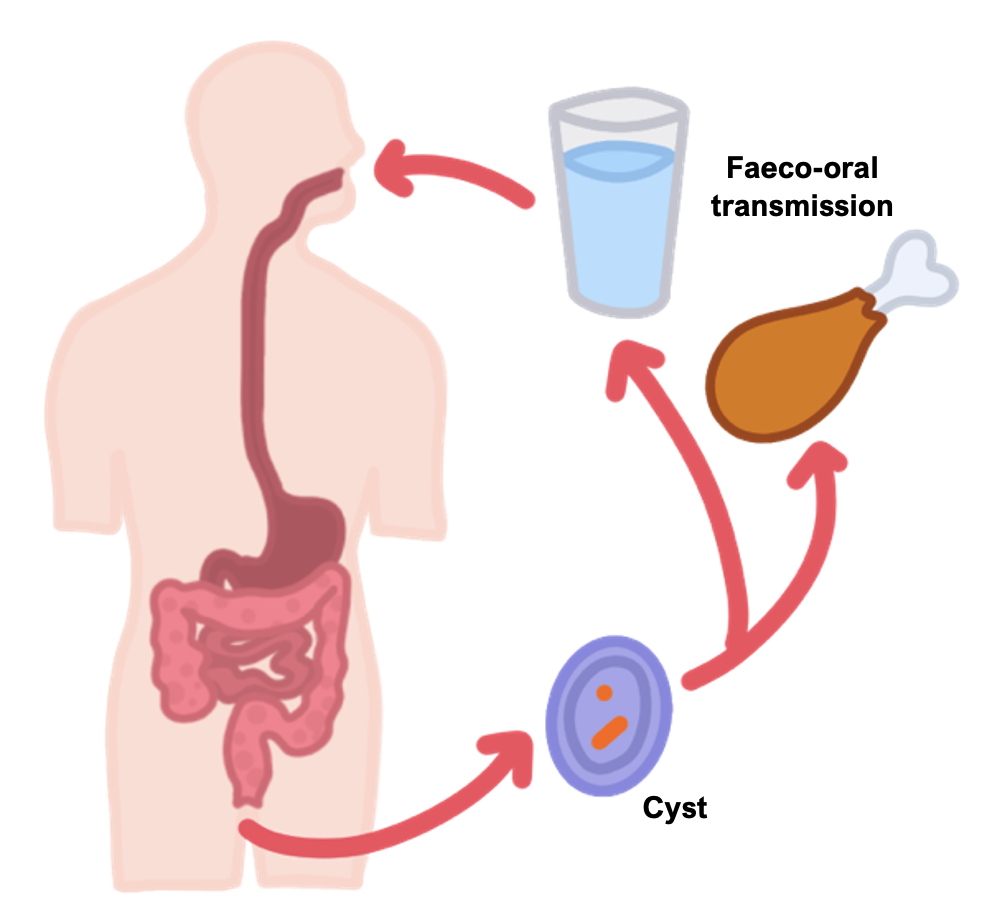Short incubation periods
Staphylococcus Aureus
A Gram-positive bacterium which produces toxins causing intestinal inflammation.
The bacteria makes enterotoxins to compete with other bacteria in cooked and processed foods, but these end up being ingested by humans, causing symptoms
The symptoms are due to the toxin rather than the bacteria, which gives the short incubation period of 1–6 hours.
Symptoms
Nausea and explosive vomiting up to 24 hours
Abdominal pain, weakness and headache
Key tests
Stool culture to assess if bacterium is present

Management
Fluid and electrolyte replacement as illness quickly resolves within a couple days
Bacillus Cereus
This is a Gram-positive rod bacterium which typically is found in the soil and water
It usually causes food poisoning but also causes host of infections in immunocompromised patients
Classically associated with eating under-cooked or reheated rice e.g. from Chinese takeaways
It cause 2 main types of syndromes:
Emetic Syndrome
This is due to ingestion of the toxin cereulide which is stable in high temperatures
This means that it survives the cooking process and can be ingested by humans
Gives vomiting 1-6 hours after ingestion and resolves within 1 day
Diarrhoeal syndrome
This is due to toxins like haemolysin which give crampy stomach pain and diarrhoea
Symptoms develop 8-15 hours after ingestion and resolve within 1 day
Management
Usually self-limiting within 24 hours
Medium incubation periods
Typhoid
This is an infection due to the bacteria Salmonella typhi, which is spread faeco-orally
Incidence is highest in children. Geographically, the highest prevalence of the disease is in India.
The bacteria infect the gut but then enter the blood giving systemic symptoms
Symptoms
Week 1 – fever with malaise, headache and cough
Week 2 – High fever (40ºC) and bradycardia
Muscle aches and complete exhaustion
Rose spots seen on lower chest + abdomen
Abdomen becomes distended with constipation
Week 3 – Complications e.g. GI bleed, meningitis,
Cholecystitis
Osteomyelitis – especially in sickle cell disease
Week 4 – Symptoms start to subside

Key tests
Cultures grown from blood, bone marrow or stool
Can also diagnose with the Widal test (serological for salmonella antigens)
Management
Oral rehydration therapy to maintain hydration and electrolytes
Antibiotics can be used, e.g., ciprofloxacin
Cholera
This an infection of the small bowel due to Gram-negative bacteria Vibrio cholerae.
It is spread by food and water contaminated by human faeces.
It colonises the small intestine, releasing cholera toxin, causing cAMP production.
This opens sodium, potassium and bicarbonate channels in cells, meaning they secrete ions and water, which leads to loss of water and rapid dehydration.
Symptoms start acute from 1–5 days after ingestion.

Symptoms
High volume watery vomit
High volume “rice-water” diarrhoea
Dehydration – cold skin, sunken eyes, wrinkling of hands and feet
Electrolyte imbalance
Key tests
Rapid dipstick test available
Stool test is definitive
Management
Oral rehydration therapy and antibiotics (doxycycline) if needed
E. Coli
This is a Gram-negative rod which is present in the gut as a commensal bacterium but can cause infection
It gives neonatal meningitis, urinary tract infections but also types of diarrhoea according to strain
Sub-classified into specific E.coli species by the antigens that trigger an immune response:
O = Lipopolysaccharide layer
K = Capsule
H = flagellin
Enterotoxigenic E. Coli
This type is the main cause of traveller’s diarrhoea spread through food and water.
It secretes enterotoxins which lead to watery diarrhoea with cramps and nausea.
Most cases resolve without antibiotics and are managed with oral rehydration salts.
Enterohaemorrhagic E. Coli
This refers to E. Coli 0157:H7 which is spread by contaminated beef.
It produces the Shiga toxin which causes a severe, haemorrhagic bloody diarrhoea.
The mortality rate is high and it can cause haemolytic uraemic syndrome in children.
Uropathogenic E. Coli
This is one of main causes of urinary tract infections
Dysentery
This is a type of gastroenteritis that causes bloody diarrhoea.
It is usually due to the bacterium Shigella which is spread by food which is contaminated with faeces.
The bacteria colonies the large intestine and makes inflammatory cytotoxins.
This leads to symptoms which usually take two or three days to develop
Symptoms
Large volume bloody diarrhoea with abdominal pain and a feeling of incomplete defecation
Fever and dehydration
Nausea/vomiting is rare
Key tests
Stool culture
Management
Oral rehydration therapy, antibiotics (e.g., ciprofloxacin) if severe
Campylobacter
This is a Gram-negative bacterium which is usually found in poultry (so enquire about chicken consumption when taking a clinical history)
The strains C. jejuni and C. coli are one of the main causes of bacterial gastroenteritis.
Symptoms usually take about 2–3 days to develop from ingestion.
Symptoms
Prodrome of fever and fatigue (flu-like)
Subsequent development of crampy abdominal pain and (bloody) diarrhoea
Can lead to Guillain-Barr. syndrome
Key tests
Stool tests
Management
Usually self-limiting and symptoms resolve after 5–7 days
Oral rehydration solution to maintain hydration and electrolytes
If severe, treat with antibiotics, e.g., clarithromycin or ciprofloxacin
Parasitic (Longest Incubation Periods)
Amoebiasis
This is an infection caused by the parasite Entamoeba histolytica. Transmission is faeco-orally.
It can be completely asymptomatic but can cause severe dysentery and liver abscesses
It is transmitted through contaminated food and water and seen more in the developing world
Symptoms
Gives bloody diarrhoea with intense abdominal pains
Can lead to ulceration of the intestines
Liver abscess – parasite enters bloodstream and migrates to liver giving RUQ pain and fever
Presents as mass in the right lobe, which is filled with pus described as “anchovy sauce”
Key tests
Need a “hot stool sample” which shows trophozoites
Serological tests (these are more sensitive if liver abscess)
Management
Metronidazole
Giardiasis
This is an infection due to the protozoan Giardia lamblia, which is spread faeco-orally.
It can be completely asymptomatic but can cause chronic diarrhoea.
It is spread when the cysts in faeces contaminate water and food, usually in the developing world.
Symptoms take 1–2 weeks to develop and last up to 6 weeks.

Symptoms
Lethargy
Abdominal pain and bloating
Chronic non-bloody diarrhoea which is foul smelling and floats
Malabsorption of nutrients – gives fatty stool, weight loss and fatigue
Key tests
Stool sample to look for trophozoites
Management
Metronidazole
Viral
Norovirus
Norovirus is the commonest viral cause of gastroenteritis. Sometimes referred to as the “winter vomiting bug.”
Virus is spread by faeco-oral route which can be in contaminated food/water but also person-to-person
Commonly spreads in environments where people kept in close contact e.g. hospitals
No vaccine exists, and alcohol hand-sanitizer is non-effective so can only prevent it by washing hands
Transmission can be aerosolized e.g. Vomiting in toilet spreads particles in air that others breathe in

Symptoms
Nausea, vomiting and watery diarrhoea
Abdominal pain and lethargy
Weakness and low-grade fever
Key tests
Stool culture PCR
Management
Disease is usually self-limiting but manage symptoms with fluids and antiemetics

